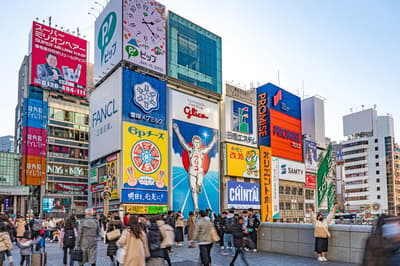The Museum of Oriental Ceramics, Osaka (MOCO) presents the special exhibition "MOCO Collection Omnibus—First-Ever and Long-Awaited Displays—PART 1," running from December 13, 2025 to March 22, 2026.
The museum opened in November 1982 to commemorate the donation of the Ataka Collection—a world-class collection of 965 Chinese and Korean ceramics assembled by the former Ataka & Co., Ltd.—by the Sumitomo Group. Between 1996 and 1998, the museum also received 351 items centered on Korean ceramics from Dr. Lee Byung-chang.
Beyond these core collections, over the 40-plus years since its opening, various philanthropists have donated numerous collections to the museum, expanding both the quality and quantity of its holdings.
This exhibition introduces five collections in an omnibus format: the Shokei Collection, featuring tea ceremony utensils most of which are being shown for the first time; the Irie Masanobu Collection of Chinese ceramic wine vessels making a return after many years; the Hakutoro Collection centered on Chinese ceramics; the Umino Nobuyoshi Collection featuring burial ceramics shaped as figures, animals, and buildings; and the Suzuki Masao Collection containing Korean ceramics and related materials from Noritaka Asakawa, a ceramic researcher who introduced the charm of Korean ceramics to Japan. Visitors can enjoy these collections that have been passed down along with the donors' wishes.
Exhibition Overview
Title: Special Exhibition "MOCO Collection Omnibus—First-Ever and Long-Awaited Displays—PART 1"
Dates: December 13, 2025 (Saturday) to March 22, 2026 (Sunday)
Venue: The Museum of Oriental Ceramics, Osaka
1-1-26 Nakanoshima, Kita-ku, Osaka (East side of Osaka Central Public Hall)
Phone: 06-6223-0055 / FAX: 06-6223-0057
Closed: Mondays, December 28, 2025 to January 5, 2026, January 13 (Tuesday), February 24 (Tuesday)
*Except holidays: January 12 (Monday) and February 23 (Monday) will be open
Hours: 9:30 AM to 5:00 PM (Last entry 4:30 PM)
*December 19 (Friday) extended until 7:00 PM for OSAKA Hikari Renaissance 2025 (Last entry 6:30 PM)
Admission:
- General: 1,600 yen (1,400 yen for groups of 20+)
- High school/University students: 800 yen (700 yen for groups of 20+)
- Free for: Junior high school students and younger, persons with disability certificates (including one caregiver), Osaka city residents aged 65+ (ID required)
- Admission includes access to all exhibitions
Organized by: The Museum of Oriental Ceramics, Osaka
Co-organized by: The Mainichi Newspapers
Exhibition Highlights
1. Mostly First-Ever Displays! Tea Ceremony Items from the Shokei Collection
The Shokei Collection centers on ceramics from China, Korea, and Japan that were used as tea ceremony utensils, also including hanging scrolls with calligraphy and paintings, tea scoops, and kettles. The collection name combines one character each from the names of the donor's parents, who were deeply versed in the tea ceremony. While a few items were previously shown in advance, this marks the first comprehensive presentation since the donation. The exhibition focuses on pre-Edo period ceramic tea utensils, including a hanging scroll of waka poetry designated as an Important Art Object.
2. Displayed Together for the First Time in About 10 Years! Distinctive Collections
Art collections strongly reflect the tastes of their collectors. Mr. Umino Nobuyoshi collected mainly mingqi (burial objects), Mr. Irie Masanobu focused primarily on Chinese ceramic wine vessels, and Mr. Usato Kinji of the Hakutoro Collection assembled Chinese ceramics across different periods. Since these collections were last shown together at the museum, the shortest interval has been 7 years and the longest 15 years. Visitors can enjoy the distinctive features of each collection being presented together again after such a long time.
Exhibition Structure and Featured Works
Part 1 (Gallery 1): Umino Nobuyoshi Collection
Twenty yong (tomb figures) and mingqi from the Han to Tang dynasties that decorated Chinese burial chambers, donated by Mr. Umino Nobuyoshi.
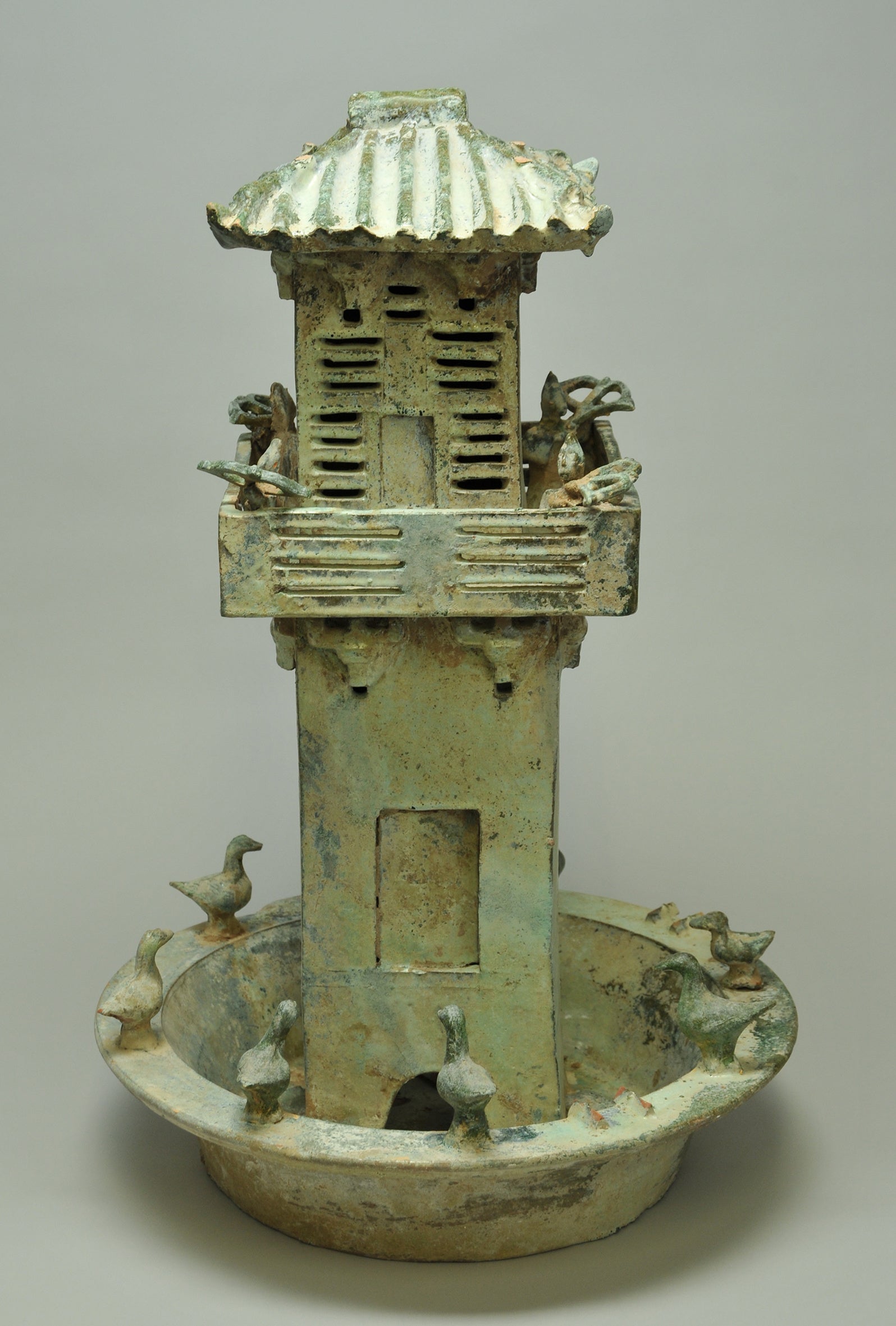
Green-Glazed Watchtower (Suisha)
Later Han Dynasty (1st–2nd century)
Donated by Mr. Umino Nobuyoshi
A mingqi modeled after a two-story watchtower standing in a pond. A figure wielding weapons stands on the second floor, while waterfowl perch around the pond. The watchtower replicates the high towers found at the mansions of powerful Later Han Dynasty nobles, symbolizing wealth and power while conveying the architectural culture of that era.
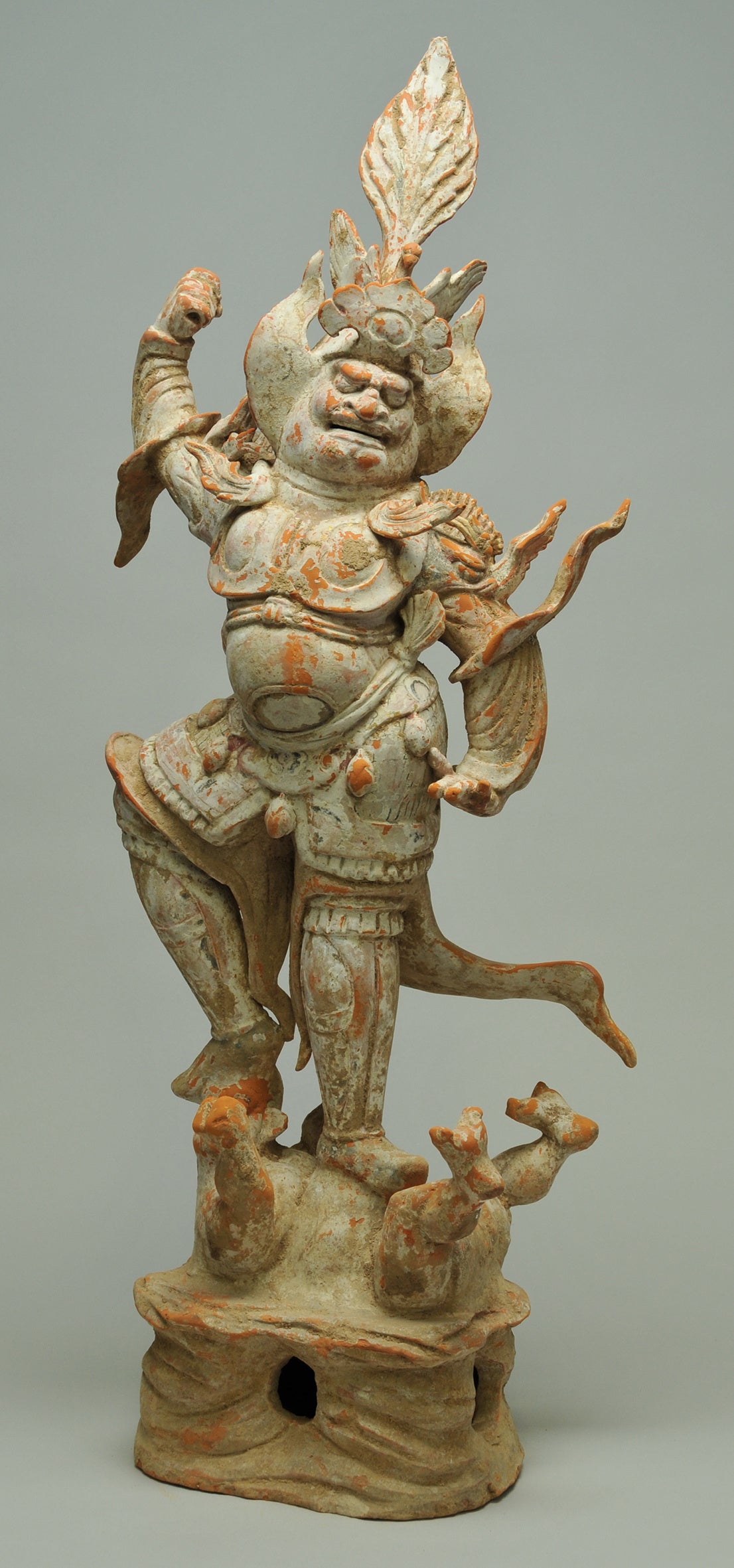
Painted Heavenly King Figure (Kasai Tenno-yo)
Tang Dynasty (8th century)
Donated by Mr. Umino Nobuyoshi
Clad in armor with a fierce expression, raising an arm while trampling a demon on a rocky base, this figure resembles Buddhist Four Heavenly Kings and guardian deity statues. Heavenly King figures were placed at tomb entrances to protect them. The ornate crown and armor, along with the dynamic, powerful form, convey the dignity befitting a tomb guardian.
Part 2 (Gallery 2): Hakutoro Collection
Thirty-seven representative works from Mr. Usato Kinji's (pen name "Hakutoro") chronological collection of Chinese ceramics.
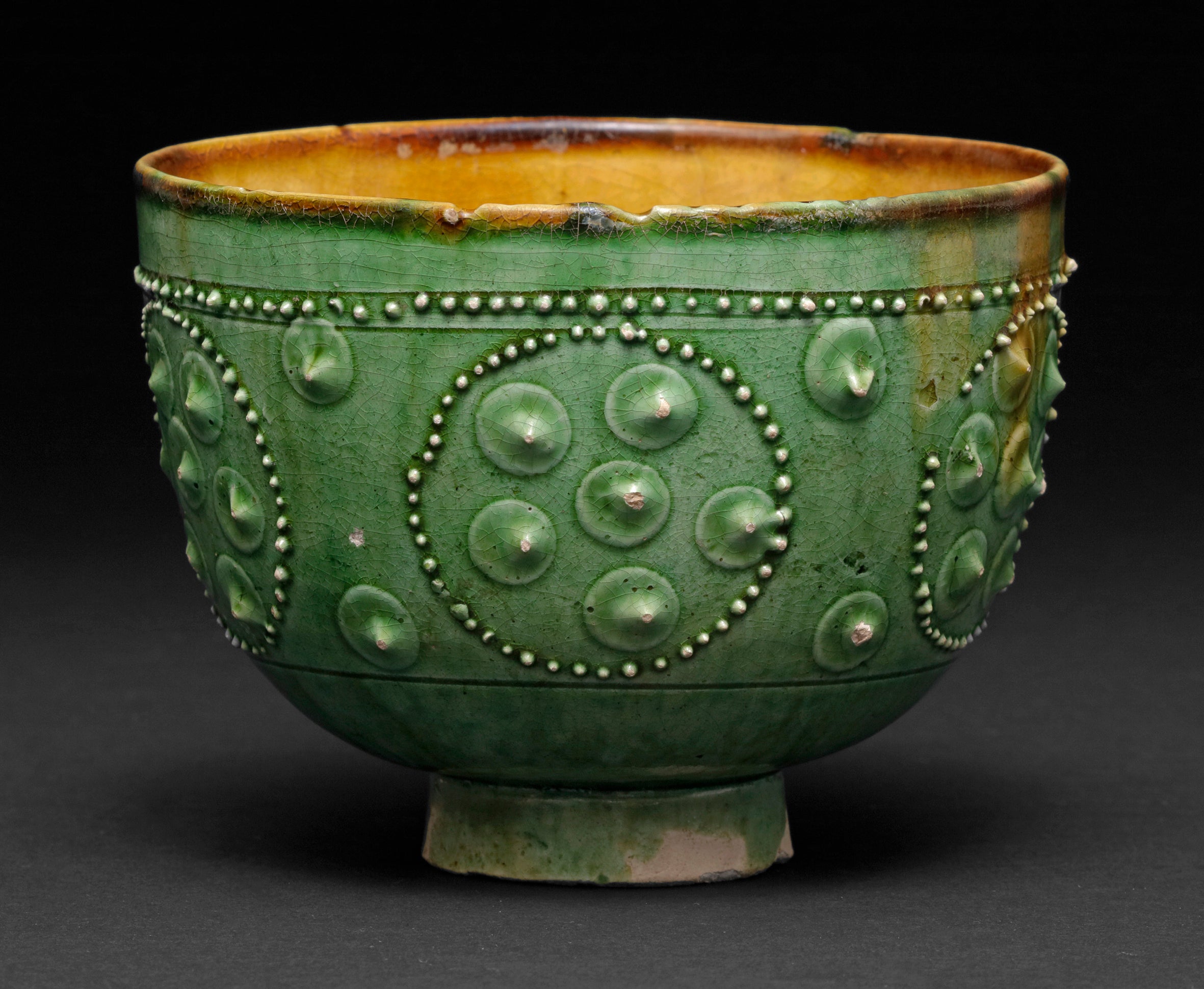
Green and Brown Glazed Bowl with Applied Beaded Design (Ryokukatsuyū Chōka Renjumon Wan)
Northern Qi to Sui Dynasty (late 6th century)
Donated by Mr. Usato Kinji / Hakutoro Collection
Photo: Mutsuda Tomohiro
A bowl where green and brown glazes beautifully contrast against the white body. The exterior features three-dimensional beaded patterns created by squeezing out clay. Based on its shape and decoration, it is thought to copy West Asian glass bowls, making it a precious work that tells the story of East-West exchange via the Silk Road.

Leaf-Patterned Tenmoku Tea Bowl (Konoha Tenmoku Chawan)
Southern Song Dynasty (12th–13th century) / Jizhou Kiln
Donated by Mr. Usato Kinji / Hakutoro Collection
The contrast between the leaf pattern made using an actual leaf and the black glaze is striking. Fired at the Jizhou Kiln in China's Jiangxi Province during the Southern Song Dynasty, it was brought to Japan and treasured as a tea ceremony utensil. Following the Japanese custom of calling black-glazed tea bowls "tenmoku," this piece is known as "Leaf Tenmoku."
Part 3 (Galleries 3 & 4): Irie Masanobu Collection
Sixty-two pieces from the Chinese ceramic collection donated by Mr. Irie Masanobu, comprehensively collected across different periods and kilns with a focus on wine vessels.

Celadon Dish with Incised Flower Design (Seiji Kokka Kamon Ban)
Jin Dynasty (12th century) / Yaozhou Kiln
Donated by Mr. Irie Masanobu
Celadons produced at Yaozhou Kiln (Shaanxi Province) are characterized by their olive-green glaze color. Using a technique called "katakiri-bori" (slant carving) where the tool blade is angled, two flowers and branches are powerfully carved inside the dish. As the glaze pools thickly in the carved recesses, rich shadows emerge in the pattern.
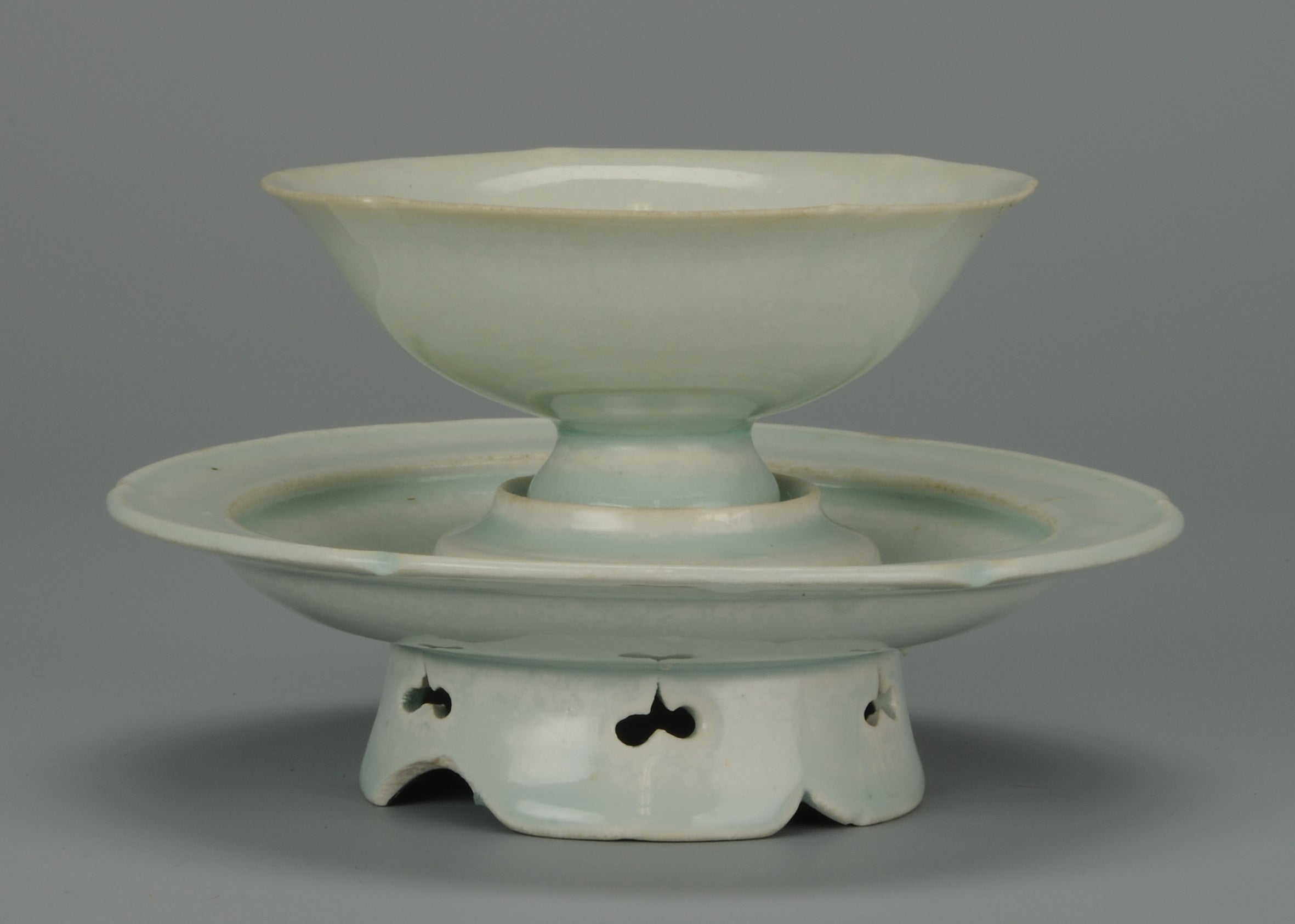
Qingbai Cup and Stand with Petal-Shaped Rim (Seihakuji Rinka Hai・Taku)
Northern Song Dynasty (11th–12th century) / Jingdezhen Kiln
Donated by Mr. Irie Masanobu
Qingbai refers to white porcelain with a bluish tinge, produced during the Northern Song Dynasty at Jingdezhen Kiln and other sites. This is a thinly made, elegant cup and stand set. Used as wine or tea vessels, the stand's rim has a shallow groove for placing the cup upside down.
Part 4 (Gallery 6): Shokei Collection
Thirty-one tea ceremony utensils composed mainly of ceramics from China, Korea, Vietnam, and Japan. Also on display is the "Ishiyama-gire" (Important Art Object), a leaf from a late Heian Period (12th century) waka poetry anthology used as a hanging scroll for tea gatherings.

Kuro-Oribe Tea Bowl with Wave Design (Kuro-Oribe Namimon Chawan)
Momoyama Period (17th century) / Mino Kiln
Shokei Collection
Photo: Kato Narifumi
The powerful tea utensil with its distorted form reflects the aesthetic sense of Furuta Oribe, a warrior and tea master who led the Momoyama Period tea ceremony. The dynamic, stylized wave pattern is striking.

White-Glazed Water Jar with Petal-Shaped Mouth (Hakudakuyū Rinkaguchi Mizusashi)
Edo Period (17th century) / Nonomura Ninsei (Omuro Kiln)
Shokei Collection
Photo: Kato Narifumi
Nonomura Ninsei is said to have come from Nonomura in Tanba Province (present-day Nantan City, Kyoto Prefecture). Around 1647, he opened the Omuro Kiln in front of Ninna-ji Temple in Kyoto and created refined tea ceremony utensils. A mizusashi (water jar) is a container for holding pure water at tea gatherings.
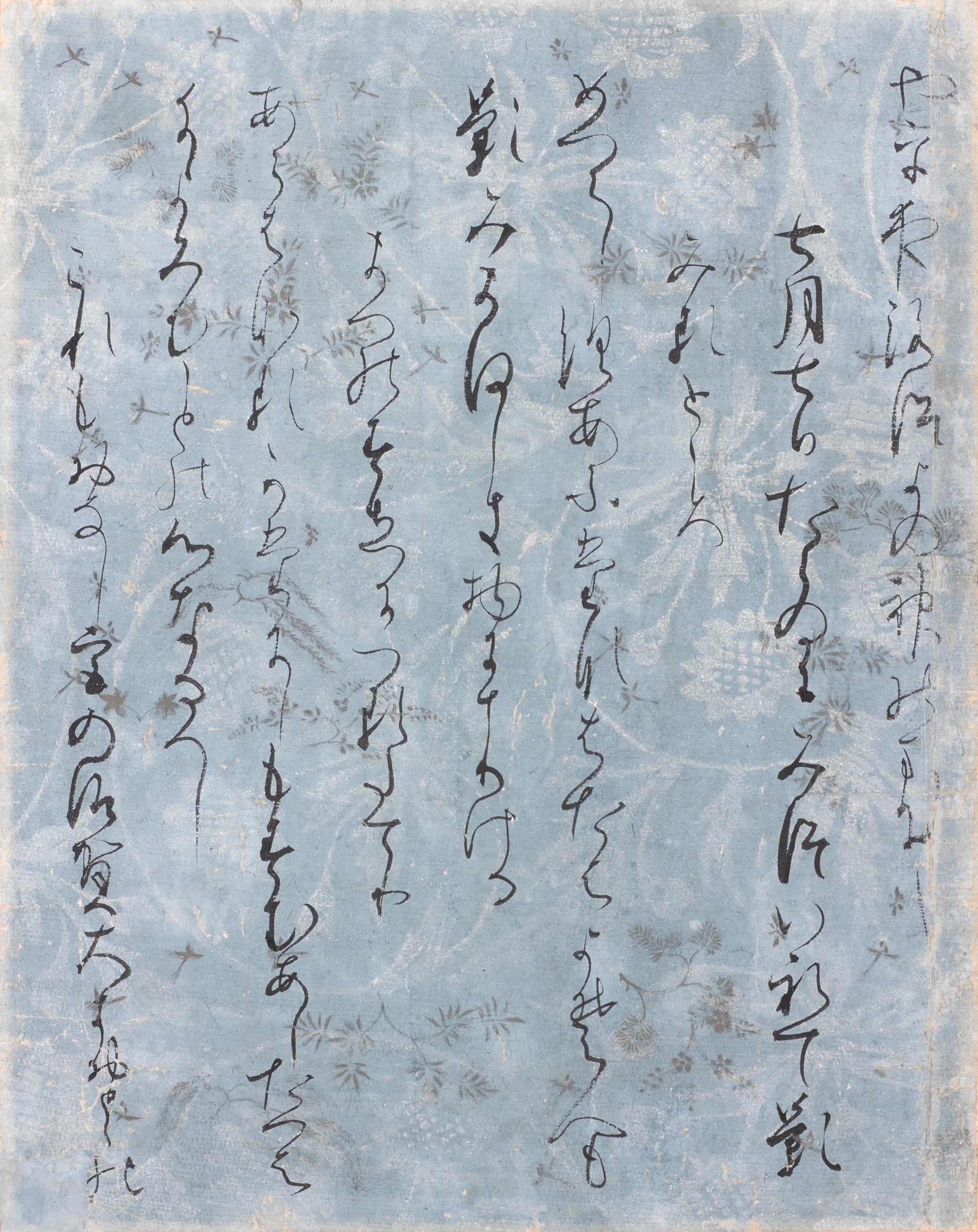
Important Art Object
Ishiyama-gire (Ise Collection)
Around 1112 (Tennei 3) / Attributed to Fujiwara no Kintō
Shokei Collection
Photo: Kato Narifumi
In 1929, two booklets including the "Ise Collection" from the "Sanjūrokunin Kashū" (Anthology of Thirty-Six Poets) preserved at Nishi Hongan-ji Temple in Kyoto were divided and made into hanging scrolls. The name derives from Ishiyama in Settsu Province (near present-day Osaka Castle), the former location of Hongan-ji Temple. Waka poems are elegantly written on dark blue paper decorated with mica and silver patterns.
Part 5 (Gallery 7): Suzuki Masao Collection
Twenty-two Korean ceramics and related materials formerly owned by Noritaka Asakawa (1884–1964), a ceramic researcher who introduced the charm of Korean ceramics to Japan.

White Porcelain Jar (Hakuji Tsubo)
Joseon Dynasty (early 18th century)
Donated by Mr. Suzuki Masao
Also called "Moon Jar" (Talhanari) in Korea, this large white porcelain jar has an almost 1:1 ratio of height to width despite its distortions, achieving balance. Asakawa Noritaka, who aspired to be a sculptor, compared white porcelain jars to ancient Greek marble sculptures and appreciated their formal beauty.

Iron-Brown Dragon Design Jar (Tessha Ryūmon Tsubo)
Joseon Dynasty (late 17th century)
Donated by Mr. Suzuki Masao
Dragons and clouds are painted with light brushwork. The dragon has a playful expression and is full of dynamism. Thought to have been used in palace ceremonies and banquets, similar pottery fragments have been excavated from the Sindae-ri Kiln (1665–1676) in Gwangju, Gyeonggi Province, which specialized in firing vessels for the royal household.
Related Programs
1. "Now's the Time to Learn" Lecture Series
Beginner-friendly lectures that explain each theme in an accessible way.
- January 24, 2026 (Saturday): "What is a Collection?" – Moriya Masafumi (Museum Director)
- March 14, 2026 (Saturday): "What are Yong (Tomb Figures)?" – Inaba Satomi (Museum Curator)
Both sessions: 10:30 AM to 12:00 PM / 2:00 PM to 3:30 PM (twice daily)
*Morning and afternoon sessions have the same content
2. Curator Lectures
Lectures to deepen knowledge focusing on works in the exhibition.
- February 14, 2026 (Saturday): "Ninsei's Ceramics—The Truth and Fiction of Images" – Kajiyama Hiroshi (Deputy Chief Curator)
10:30 AM to 12:00 PM / 2:00 PM to 3:30 PM (twice daily)
*Morning and afternoon sessions have the same content
For Programs 1 & 2:
Participation fee: 500 yen (separate admission required)
Venue: The Museum of Oriental Ceramics, Osaka, Basement Lecture Hall
*Advance registration required, first-come basis (capacity 45 per session)
*Details will be posted approximately one month in advance. Register through the museum's ticket purchase page.
3. Director's Special Night Talk
Director Moriya Masafumi will conduct a gallery talk about highlighted works in the exhibition galleries.
- December 19, 2025 (Friday) 6:00 PM to 6:40 PM
Meeting point: The Museum of Oriental Ceramics, Osaka, Entrance Hall
No registration required, participation free (separate admission required)
Concurrent Exhibitions
Special Displays:
- National Treasure "Oil-Spot Tenmoku Tea Bowl" (Display Lobby 1)
- "Blue and White Jar with Tiger and Magpie Design" (Display Lobby 2)
Collection Exhibitions:
- "Pure Beauty—Lee Byung-chang Collection Korean Ceramics" (Gallery 5)
- "Love of Earth and Clay—Contemporary Ceramic Art Collection" (Gallery 8)
- "Supreme Elegance—Ataka Collection Chinese Ceramics" (Gallery 9)
- "Eternal Azure—Ataka Collection Chinese Ceramics" (Gallery 10)
- "Pure and Refined—Ataka Collection Korean Ceramics" (Gallery 11)
- "Hundred Snuff Bottles in Bloom—Oki Shoichiro Collection" (Gallery 12)
- "Clay Never Dies—Contemporary Ceramic Art Collection" (Gallery 13)



